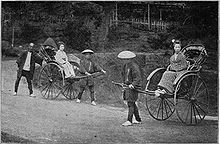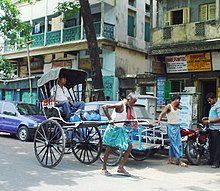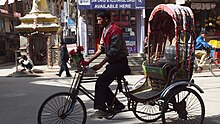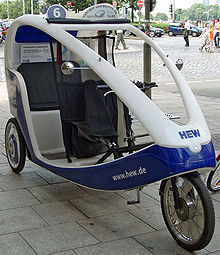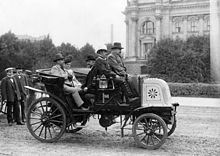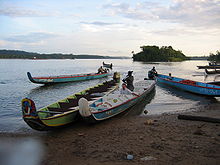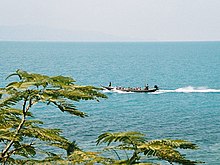History of the taxi
The history of the taxi encompasses the entire period in which people use other people for personal transportation for a fee. Accordingly, it ranges from the paid chaises in earlier times who transported others using their own muscle power, to the historical power hackney , to today's passenger transport with motor vehicles, boats and small planes. According to the traffic routes used for this purpose, road taxis , water taxis and air taxis can be distinguished today . The taxi traffic changed and expanded with the traffic engineering possibilities. The history of the taxi can be understood as a quantitative and a qualitative development. The quantitative one is based on a range of transport options that has become increasingly broader with technical progress, the qualitative one from the increasing demands of the passengers on comfort, safety and speed of the means of transport. The history of the taxi thus shows itself as an accompanying event to the development of the traffic system and to the progress of human civilization. During this long period of time, the phenomenon known internationally today as “taxi” has been given numerous different names, some of which still exist today.
Muscle-powered taxis
Chaise taxi
The earliest pre-human transport, which though initially only a rich upper class in the advanced civilizations of China , Mesopotamia , Egypt was reserved and later travelers in poor countries is that Chaisentaxi, the litter , which also palanquin was called. Sedan chairs were transport chairs or closed transport chambers carried on bars by humans or animals. They served high dignitaries as so-called portechaises, which on the one hand made the street public the rank of what was worn and on the other hand helped avoid direct contact with the dirt and rubbish of the paths. In the early days, slaves were usually responsible for the work of the litter-bearer. Since the 17th century, litters in Europe were also available for general public use in larger cities. For example, on January 1, 1638, at the instigation of Elector Friedrich Wilhelm, 12 sedan chairs with 24 porters were set up in front of the Berlin City Hall for local public transport.
As part of state job creation measures , the Huguenots who immigrated from France became the first guild-like operators of the chaise-bearer trade. Captured Turks later took on this task, which was increasingly taken up by the population. Due to the poor road conditions, the chaise taxi, for example in Vienna and Dresden, was able to hold its own against the competition of the emerging cabs and cabs until the second half of the 19th century.
Rickshaw


With the advent of the so-called rickshaw, a pedestrian taxi, the guests to be transported were no longer carried, but transported in a two-wheeled vehicle, which was called the rickshaw in Asia . This no longer required four to six people to transport passengers. To transport one person, depending on the road conditions, a rickshaw driver was usually sufficient, as a human pulling force between two bars in front of the vehicle rolling on wheels. To cope with longer stretches and difficult passages, e.g. B. a steeper terrain, a helper was hired. Pedestrian taxis of this kind, using muscle power, have become rare today, but can still be seen occasionally, for example in the heavy traffic on Indian streets, especially in Calcutta . In Japan , rickshaws can still be found today for short transport routes, especially as a tourist attraction, near sights.
Bicycle taxi
With the advent of the bicycle as an individual means of transportation and the improvement of road conditions the pedestrian rickshaw was increasingly called bicycle taxis replaced, the largest in its area of distribution, the Asian countries rickshaw , in countries such as Austria velotaxi and Africa boda-boda were called. As a convenience option, passengers could choose an open or closed hood that protected them from dust and rain. Cycle rickshaws had the advantage of being able to transport passengers faster and over longer distances. They are still today, in a modern design and adapted to the increased volume of traffic in terms of safety requirements, in many larger cities around the world such as Hamburg , Berlin , Moscow or Kathmandu for local public transport or as a tourist attraction.
Horse-drawn taxis
Fiaker
The horse taxis began in France with the horse-drawn carriage, after the horse dealer Nicolas Souvage founded a wage-wage company in 1662 in the Rue de Saint Fiacre in Paris . The road and vehicle were named after the Irish-French hermit Fiacrius , who also became the namesake of the fiakers. The new term referred to both the carriage and the driver of the wage-based vehicle.
The first Fiaker license was issued in Vienna in 1693, and around 1700 there were already around 700 wage carriages in the city. Fiakers are traditionally designed as two-in-hand horses, which, in addition to the coachman, allowed up to five people to be transported. Fiakers can be used with the roof open or closed, depending on the weather. The guild of Fiaker, which had existed since 1785, was so defining for the external image of Vienna that on the occasion of its centenary in 1885 the so-called Fiakerlied was created, which was to become one of the most famous Viennese songs and with the repositioning of the first verse “ I guide 'zwa harbe rappen ”in“ I have an old Daimler. . . “By the hit poet Fritz Löhner advanced to a kind of professional song for taxi drivers.
The professional pride of the Viennese fiaker can be heard from the verses of the song:
“I’ll drive from the trunk to the pleasure house in twelve minutes;
I can't jump into a gallop,
It only goes limp, limp, limp;
When it really shoots afterwards, I feel it inside me,
That I have the right paws, that I am a cab driver.
Anyone can be a coachman,
But kinnans only drive in Wean. "
And the chorus of the song is:
"My pride is, I'm holding onto real Weanakind,
A Fiaker, how you can not find every day,
My Bluat is as airy and light as the wind
I'm a real Weanerkind. "
The traditional Fiakers in Austria today are mainly only available in Salzburg and Vienna as wage-coach offers for tourist city tours and for celebrations such as the transport of wedding parties to the town hall or to church services. Even in the Czech spa towns of Karlsbad and Marienbad , the fiakers still determine the old town. In Rome , the new mayor is planning to ban the horse-drawn carriages as disruptive factors in city traffic.
Horse cab
Based on the model of the Fiaker, the so-called " Droschken " emerged in Germany . The term cab was formed from the Russian word "drožki" ( дрожки ). He initially identified a vehicle that was pulled by horses and was therefore also referred to as a "horse cab". The driver was called a cab driver. The first cabs, with which the Dessau horse dealer Alexander Mortier set up a rental carriage service around 1815, came from Warsaw, Poland, to the Prussian capital Berlin . In 1827 his company was running 120 cabs in the city. They were numbered for precise identification.
Through popular books such as the novel " Der eiserne Gustav " by Hans Fallada and corresponding film adaptations with Heinz Rühmann and Gustav Knuth , the ideas of the cab system were closely connected with the city of Berlin in the period that followed. After the famous cab driver Simon Kremser , the cab type was also called " Kremser ". With the Kremser, the development of the introduction of a regular taxi service and the transport of larger groups of people began. As an unmistakable phenomenon of the times, cabs have also found their way into artistic representations, for example in the painting by the Impressionist painter Leo Lesser Ury (November 7, 1861 to October 18, 1931) from 1920 (see picture).
Cab
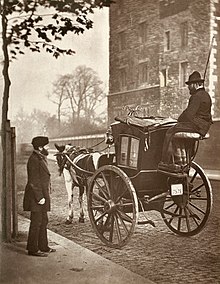
In the streets of British London a type of carriage appeared since 1588, which was called an abbreviation of the French term cabriolet "Cab" and referred to a two-wheeled, open, single-horse carriage that was available as a rental carriage for two to three people. According to the Hackney horse breed, preferred as carriage horses , the vehicle was put into taxi service as a two-wheeled “Hackney Cabriolet” or four-wheeled “Hackney Carriage”. Both expressions were short for "taxi" in English. When the designer Joseph A. Hansom invented and built a new carriage shape around 1834, which was steered over the guest cabin from a driver's seat raised at the back, the name Hansom Cab came about for a taxi shape that was to dominate the streetscape of Victorian London. Similar to the cab on the mainland, the name Cab was adopted when motor cabs had already replaced horse cabs. In New York the yellow taxis are still called "Yellow Cab", officially New York City Taxi Cab , colloquially as "Taxi Cab".
Motorized taxis
Car taxi
Shortly after the designer Carl Benz had created the first motorized automobile in 1886, the entrepreneurs Friedrich Lutzmann and his friend Fritz Koch used the new vehicle technology to found Germany's first taxi company with motorized vehicles in Dessau in 1893 . Around the turn of the century, the first powerhouses also operated in Berlin (see picture). While word combinations with the term rickshaw prevailed in the Asian countries , the name "hackney" was initially retained for the petrol-engined vehicles that became increasingly popular in Europe at the turn of the 20th century. The only distinction between the new rental cars and the “horse-drawn cabs” was by identifying them as “motorized cab”, “power cab” or “car”. The first motorized cabs were largely similar to the horse cabs that had been common up until then. The team of horses and the drawbars were only replaced by an engine block that was operated from the raised coachman's seat. A taximeter, which was linked to the engine as a mechanical counter, was first used in the Daimler Victoria in 1896. In 1897 the first street taxi in Stuttgart used the taximeter invented by Friedrich Wilhelm Gustav Bruhn . This device, which determines the fare, gave rise to the generally accepted international term “taxi” for commercially available vehicles that can be rented for private passenger transport with a driver.

According to official regulations, taxis should clearly stand out from the traffic by means of a special marking. Since the 1930s, for example, German taxis were recognizable by the diced stripes under the windows (see picture), the "New York City Cabs" were painted bright yellow all around, and in West Germany the color of taxis was changed from black to light ivory by ordinance in 1971 changed. In the early autotaxes, the sign identifying the vehicles as taxis was either placed behind the windshield or was attached to the left exterior mirror like a traffic light. Since the color approval, today's taxis have been drawing attention to themselves with a yellow-black attachment on the car roof (see picture). Illuminating the taxi sign makes it recognizable as a free taxi.
Auto rickshaw

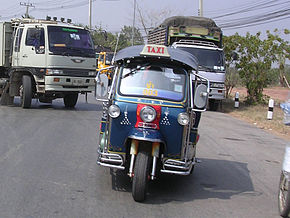
The motorization of vehicles from Germany quickly spread across the world. In the second half of the 20th century, a type of motorized vehicle spread from Japan over the entire Asian region, which was given the addition of “auto rickshaw” as a continuation of the well-known forms of transport as motorized rickshaws. Depending on the country they could, "trishaw", "Moto" ( "motor rickshaw" Peru ) for their clattering engine noise or onomatopoeic are called "tuk-tuk". These vehicles can still be found today in large numbers in countries such as India , Pakistan , Bangladesh , Laos , Thailand , Sri Lanka , the Philippines , but also in Ethiopia and Kenya . These are mostly three-wheeled small vehicles that provide inner-city private passenger transport. On German roads are auto rickshaws since 2007 electro-motorized as an environmentally friendly so-called "E-tuk tuk" go.
Motorbike taxi
In the congested cities of Asia, getting through with bulky rickshaws or western car taxis was cumbersome and wasted a lot of time. So-called motorcycle taxis found a niche in the transport sector, with which the need for transport could be satisfied relatively optimally. As a two-wheeled version, they were superior to three-wheeled motor rickshaws in terms of traffic management. They offered themselves as an inexpensive alternative for quick relocation with individuals without a lot of luggage. They also required little investment for the taxi driver. As a two-wheeled, agile, fast means of transport in the traffic jams in cities such as Calcutta , New Delhi , Bangkok or Shanghai, they began to dominate passenger transport over the broader car taxis. Concentrated at certain assembly points - in Bangkok, for example - passengers can recognize them through the driver's orange vests and white helmets (see picture). The motorcycle taxis are called Bodabodas in Uganda and Kenya .
Water taxi
With the advent of outboard motors, it was also possible to move boats with motor power and use them for taxi services on waterways. Thus, even in countries characterized by river landscapes, a brisk taxi traffic on the water developed. The so-called water taxis made it possible for passengers to get to their destination conveniently on the waterway, even if there was no infrastructure with earth-bound roads, as is typical for the country. As a means of local transport, water taxis still handle river traffic on the waterways of Indonesia , Thailand or French Guiana . They serve as means of transport in lagoon cities like Venice , as feeders in ports like Hamburg or Copenhagen . They operate on Lake Zurich and connect islands and towns in lake landscapes with one another, such as in Hiddensee or Istanbul . The name “water taxi” seems so attractive that boat entrepreneurs on the Havel or in the waters around New York use the well-known figurative marking with a row of dice, the yellow color and the inscription “water taxi” even for their excursion boats for larger groups Use ships.
Air taxi


When motorized air transport developed in the first half of the 20th century, pilots were soon also offering their services for private passenger transport using their aircraft. Based on the land-based commercial passenger transport, they named their means of transport " Lufttaxi " or "Air taxi". This new type of taxi carried people on demand on routes that were difficult or impossible to reach by land. You convey z. B. People between small islands such as the Falkland Islands . They provide shuttle services between the mainland and individual islands such as in North Frisia or the Maldives . They created air connections to villages or farms located further apart in desert or jungle areas such as Australia , New Zealand , Alaska and Canada .
In Germany, an air taxi airline with headquarters in Dortmund was formed , which was called Lufttaxi Dortmund and operated individual Europe-wide business flights with four machines, but ceased operations again after a short time.
In the Maldives , the Dane Lars Erik Nielsen created a fleet of 41 Twin Otter aircraft based on Malé International Airport , which he named “Maldivian Air Taxi”. It existed from 1993 to 2013 and then merged with Trans Maldivian Airways . The machines designed for take-offs and landings on the water have been using the callsign "Air-Taxi" since then. They act as island feeders for tourists to the approximately forty islands of the archipelago and can take up to eighteen travelers on board.
The air taxi company ImagineAir , founded in 2005 and based in Georgia / USA, still serves an airspace radius of 600 kilometers in private charter operations with three small aircraft of the type Cirrus SR22 .
literature
- GN Georgano (Ed.): Complete Encyclopedia of Motorcars, 1885 to the Present. 2nd Edition. Dutton Press, New York 1973, ISBN 0-525-08351-0 . (English)
- Josef Ihle: From horse-drawn cab to car-taxi. 100 years of history of the cab trade , Verlag Heinrich Vogel, Munich 1958.
- Ulrich Kubisch: Taxi - the most mobile business in the world . Nicolaische Verlagsbuchhandlung, Berlin 1993, ISBN 3-87584-489-0 .
- Barthel F. Sinhuber: The Fiaker of Vienna . Dachs-Verlagsgesellschaft, Vienna 1992, ISBN 3-85058-064-4 .
- Ernest Henry Wakefield: History of the Electric Automobile; Battery-Only Powered Cars. Published by SAE (Society of Automotive Engineers), Warrendale PA 1970, ISBN 1-56091-299-5 . (English)
Web links
- History of Taxis , accessed February 7, 2017
- Local transport in Berlin before 1900. In: History of Berlin. Retrieved February 3, 2017 .
- From sedan chair to horse-drawn carriage , Planet Wissen, accessed February 3, 2017
- The forerunner of taxis , accessed February 7, 2017
- Pictures from the history of the taxi , accessed on February 7, 2017
Individual evidence
- ↑ Carlos Juliao and the image of black slaves in the late eighteenth century Brazil , In: Slavery & Abolition, Volume 23 (2002), pp. 125–146
- ^ Berlin local transport before 1900. In: History of Berlin. Retrieved February 3, 2017 .
- ^ Gerhard Fischer: The Huguenots in Berlin , Hentrich & Hentrich Verlag, Berlin 2010
- ↑ Barthel F. Sinhuber: The Fiaker of Vienna . Dachs-Verlagsgesellschaft, Vienna 1992
- ^ Elisabeth Theresia Fritz, Helmut Kretschmer: Vienna, music history: folk music and Viennese song: Part 1 . LIT, Vienna 2006, p. 366.
- ↑ Rome's mayor wants to ban Fiaker from the city orf.at, October 19, 2016, accessed February 3, 2017
- ↑ Wolfgang Pfeifer u. a .: Etymological Dictionary of German , Deutscher Taschenbuch Verlag, 8th edition, Munich 2005, p. 246
- ↑ http://www.chronik-berlin.de/bvg_tram-1.htm Berlin local transport before 1900, History of Berlin , accessed on February 3, 2017
- ↑ Josef Ihle: From the horse-drawn cab to the car-taxi. 100 years of history of the cab trade , Verlag Heinrich Vogel, Munich 1958
- ^ History of Taxis , accessed February 7, 2017
- ^ Tuk-tuk taxi in India. The Bollywood swing on focus.de; accessed on February 4, 2017
- ↑ Boda-Boda Taxi Bicycles for Africa
- ↑ aviainfo.gov.mv - Official aircraft register (English; PDF; 39 kB), accessed on February 7, 2017.
- ↑ blackstone.com - Blackstone Announces Acquisition of a Majority Stake in Maldivian Air Taxi and Trans Maldivian Airways , accessed February 7, 2017
- ↑ FAA - Official Aircraft Register (English) accessed on February 7, 2017


